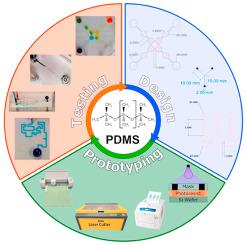当前位置:
X-MOL 学术
›
Anal. Chim. Acta
›
论文详情
Our official English website, www.x-mol.net, welcomes your feedback! (Note: you will need to create a separate account there.)
A practical guide to rapid-prototyping of PDMS-based microfluidic devices: A Tutorial
Analytica Chimica Acta ( IF 6.2 ) Pub Date : 2020-10-01 , DOI: 10.1016/j.aca.2020.09.013 Giorgio Gianini Morbioli , Nicholas Colby Speller , Amanda M. Stockton
Analytica Chimica Acta ( IF 6.2 ) Pub Date : 2020-10-01 , DOI: 10.1016/j.aca.2020.09.013 Giorgio Gianini Morbioli , Nicholas Colby Speller , Amanda M. Stockton

|
Micro total analytical systems (μTAS) are attractive to multiple fields that include chemistry, medicine and engineering due to their portability, low power usage, potential for automation, and low sample and reagent consumption, which in turn results in low waste generation. The development of fully-functional μTAS is an iterative process, based on the design, fabrication and testing of multiple prototype microdevices. Typically, microfabrication protocols require a week or more of highly-skilled personnel time in high-maintenance cleanroom facilities, which makes this iterative process cost-prohibitive in many locations worldwide. Rapid-prototyping tools, in conjunction with the use of polydimethylsiloxane (PDMS), enable rapid development of microfluidic structures at lower costs, circumventing these issues in conventional microfabrication techniques. Multiple rapid-prototyping methods to fabricate PDMS-based microfluidic devices have been demonstrated in literature since the advent of soft-lithography in 1998; each method has its unique advantages and drawbacks. Here, we present a tutorial discussing current rapid-prototyping techniques to fabricate PDMS-based microdevices, including soft-lithography, print-and-peel and scaffolding techniques, among other methods, specifically comparing resolution of the features, fabrication processes and associated costs for each technique. We also present thoughts and insights towards each step of the iterative microfabrication process, from design to testing, to improve the development of fully-functional PDMS-based microfluidic devices at faster rates and lower costs.
中文翻译:

基于 PDMS 的微流体设备快速原型制作实用指南:教程
微型全分析系统 (μTAS) 具有便携性、低功耗、自动化潜力以及低样品和试剂消耗量,从而减少废物产生,因此对化学、医学和工程等多个领域具有吸引力。全功能 μTAS 的开发是一个迭代过程,基于多个原型微器件的设计、制造和测试。通常,微制造协议需要一周或更长时间的高技能人员在高维护洁净室设施中工作,这使得这种迭代过程在全球许多地方成本过高。快速原型制作工具与聚二甲基硅氧烷 (PDMS) 的使用相结合,能够以较低的成本快速开发微流体结构,规避传统微加工技术中的这些问题。自 1998 年软光刻问世以来,文献中已经证明了多种快速成型方法来制造基于 PDMS 的微流体装置;每种方法都有其独特的优点和缺点。在这里,我们提供了一个教程,讨论当前用于制造基于 PDMS 的微器件的快速原型技术,包括软光刻、印刷和剥离和支架技术等方法,特别是比较特征的分辨率、制造工艺和相关成本每种技术。我们还提出了对迭代微制造过程的每一步的想法和见解,从设计到测试,以更快的速度和更低的成本改进全功能的基于 PDMS 的微流体设备的开发。自 1998 年软光刻问世以来,文献中已经证明了多种快速成型方法来制造基于 PDMS 的微流体装置;每种方法都有其独特的优点和缺点。在这里,我们提供了一个教程,讨论当前用于制造基于 PDMS 的微器件的快速原型技术,包括软光刻、印刷和剥离和支架技术等方法,特别是比较特征的分辨率、制造工艺和相关成本每种技术。我们还提出了对迭代微制造过程的每一步的想法和见解,从设计到测试,以更快的速度和更低的成本改进全功能的基于 PDMS 的微流体设备的开发。自 1998 年软光刻问世以来,文献中已经证明了多种快速成型方法来制造基于 PDMS 的微流体装置;每种方法都有其独特的优点和缺点。在这里,我们提供了一个教程,讨论当前用于制造基于 PDMS 的微器件的快速原型技术,包括软光刻、印刷和剥离和支架技术等方法,特别是比较特征的分辨率、制造工艺和相关成本每种技术。我们还提出了对迭代微制造过程的每一步的想法和见解,从设计到测试,以更快的速度和更低的成本改进全功能的基于 PDMS 的微流体设备的开发。
更新日期:2020-10-01
中文翻译:

基于 PDMS 的微流体设备快速原型制作实用指南:教程
微型全分析系统 (μTAS) 具有便携性、低功耗、自动化潜力以及低样品和试剂消耗量,从而减少废物产生,因此对化学、医学和工程等多个领域具有吸引力。全功能 μTAS 的开发是一个迭代过程,基于多个原型微器件的设计、制造和测试。通常,微制造协议需要一周或更长时间的高技能人员在高维护洁净室设施中工作,这使得这种迭代过程在全球许多地方成本过高。快速原型制作工具与聚二甲基硅氧烷 (PDMS) 的使用相结合,能够以较低的成本快速开发微流体结构,规避传统微加工技术中的这些问题。自 1998 年软光刻问世以来,文献中已经证明了多种快速成型方法来制造基于 PDMS 的微流体装置;每种方法都有其独特的优点和缺点。在这里,我们提供了一个教程,讨论当前用于制造基于 PDMS 的微器件的快速原型技术,包括软光刻、印刷和剥离和支架技术等方法,特别是比较特征的分辨率、制造工艺和相关成本每种技术。我们还提出了对迭代微制造过程的每一步的想法和见解,从设计到测试,以更快的速度和更低的成本改进全功能的基于 PDMS 的微流体设备的开发。自 1998 年软光刻问世以来,文献中已经证明了多种快速成型方法来制造基于 PDMS 的微流体装置;每种方法都有其独特的优点和缺点。在这里,我们提供了一个教程,讨论当前用于制造基于 PDMS 的微器件的快速原型技术,包括软光刻、印刷和剥离和支架技术等方法,特别是比较特征的分辨率、制造工艺和相关成本每种技术。我们还提出了对迭代微制造过程的每一步的想法和见解,从设计到测试,以更快的速度和更低的成本改进全功能的基于 PDMS 的微流体设备的开发。自 1998 年软光刻问世以来,文献中已经证明了多种快速成型方法来制造基于 PDMS 的微流体装置;每种方法都有其独特的优点和缺点。在这里,我们提供了一个教程,讨论当前用于制造基于 PDMS 的微器件的快速原型技术,包括软光刻、印刷和剥离和支架技术等方法,特别是比较特征的分辨率、制造工艺和相关成本每种技术。我们还提出了对迭代微制造过程的每一步的想法和见解,从设计到测试,以更快的速度和更低的成本改进全功能的基于 PDMS 的微流体设备的开发。


























 京公网安备 11010802027423号
京公网安备 11010802027423号